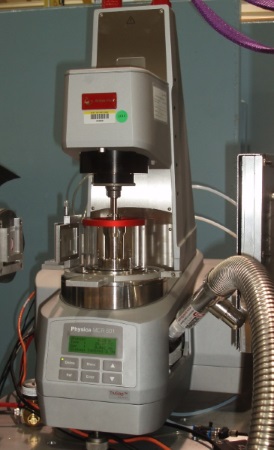
| Instrument Specifications: | |
| Accuracy | 1% of maximum value |
| Torque Range | 0.05 µNm - 230 mNm |
| Torque Resolution | 0.1 nNm |
| Speed Range | 10-7 min-1 to 3000 min-1 |
| Angular Deflection | 0.1µrad to ∞ |
| Angular Frequency Range | 10-5 rad/s to 628 rad/s |
| Temperature Range | −40 to 200 °C |
| Quartz Cup Diameter(s) (ID) | 50 mm |
| Titanium Cup Diameter(s) (ID) | 50 mm, 30 mm, 29 mm, 28 mm |
| Quartz Bob Diameter(s) (ID) | 49 mm, 29 mm |
| Titanium Cup Diameter(s) (ID) | 49 mm, 48 mm, 29 mm, 28 mm, 27 mm |
| Sample Volume, 50mm cup-49mm bob | 11 ml |
| Sample Volume, 50mm cup-48mm bob | 14 ml |
| Sample Volume, 30mm cup-29mm bob | 3.75 ml |
| Sample Volume, 29mm cup-28mm bob | 3.5 ml |
The NCNR has two Anton Paar MCRXX11 series stress-controlled rheometers available to simultaneously probe the shear rheology and the material microstructure using SANS. The flow geometry consists of a Couette type cell and SANS can probe the 1,3 and 2,3 planes of flow.
Neutron transparent quartz and titanium inner and outer cylnders are available with flow gaps ranging from 0.5 mm to 1.5 mm. The sample valoumes range from 3.5 ml for the smallest combination up to 14ml for the largest.
A range of rheological tests can be performed in conjuction with SANS from the most basic of stress-controlled steady shear mode to more advanced time-dependent measurement such as large-amplitude oscillatory shear (LAOS) mode. For steady shear mode, the SANS measurements and the rheological measurements are synched using a series of TTL on/off signals. Multiple shear measurements can be recorded between each SANS measurement and multiple SANS data sets can be measured at a single shear rate. For repeatable, time-dependent behavior of a sample, the time relative to the start of each repeat can be assigned to each neutron captured by the detector, in addition to the coordinate position of the event on the detector. Using post-processing techniques, multiple histograms can be made from original data for a specific time region alogn each repeat or oscillation.
Posters outlining the workings and science related to the rheometer:
*Disclaimers:
| SANS Home | | SANS Instruments | | Sample Environments | | SANS Publications | | Instrument Schedules | | Low-Q Seminar Series | | SANS Staff | | Data Reduction and Analysis | | Tutorials | | Info For Users | | SANS Calculations |
Last modified 06-November-2014 by website owner: NCNR (attn: Jeff Krzywon)